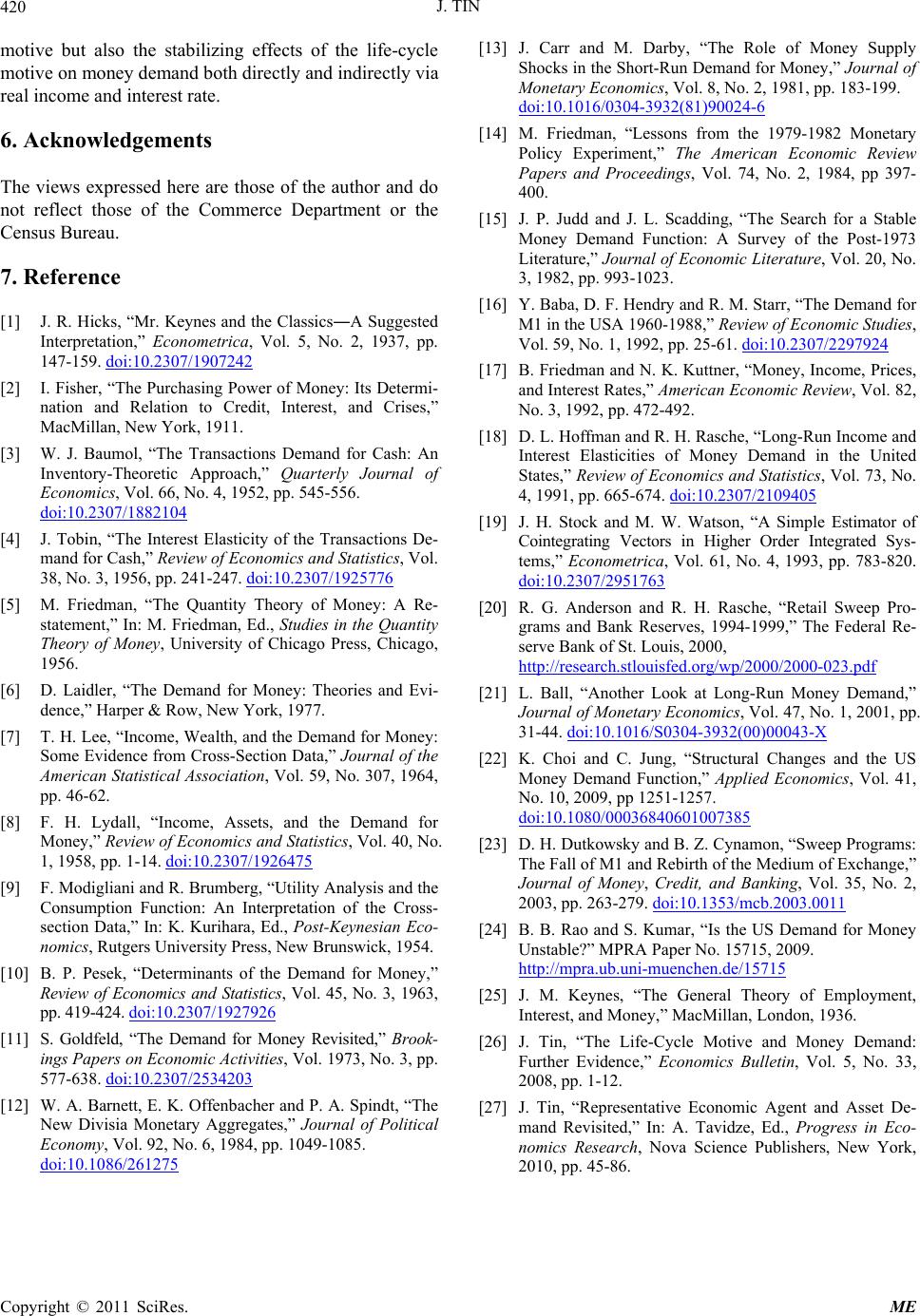
J. TIN
420
those of the author and do
not reflect those of the Commerce Department or the
Mr. Keynes and the Classics―A Suggested
Interpretation,” Econometrica, Vol. 5, No. 2, 1937, pp
motive but also the stabilizing effects of the life-cycle
motive on money demand both directly and indirectly via
real income and interest rate.
6. Acknowledgements
The views expressed here are
Census Bureau.
7. Reference
[1] J. R. Hicks, “
.
147-159. doi:10.2307/1907242
[2] I. Fisher, “The Purchasing Power of Money: Its Determi-
nation and Relation to Credit, Interest, and Crises,”
Quarterly Journal of
MacMillan, New York, 1911.
[3] W. J. Baumol, “The Transactions Demand for Cash: An
Inventory-Theoretic Approach,”
Economics, Vol. 66, No. 4, 1952, pp. 545-556.
doi:10.2307/1882104
[4] J. Tobin, “The Interest Elasticity of the Transact
mand for Cash,” Revie
ion
w of Economics and Statistics
s De-
, Vol.
38, No. 3, 1956, pp. 241-247. doi:10.2307/1925776
[5] M. Friedman, “The Quantity Theory of Money: A Re-
statement,” In: M. Friedman, Ed., Studies in the Quantity
Theory of Money, University of Chicago Press, Chicago,
1956.
[6] D. Laidler, “The Demand for Money: Theories and Evi-
dence,” Harper & Row, New York, 1977.
Journal of the
view of Economics and Statistics, Vol. 40, No.
[7] T. H. Lee, “Income, Wealth, and the Demand for Money:
Some Evidence from Cross-Section Data,”
American Statistical Association, Vol. 59, No. 307, 1964,
pp. 46-62.
[8] F. H. Lydall, “Income, Assets, and the Demand for
Money,” Re
1, 1958, pp. 1-14. doi:10.2307/1926475
[9] F. Modigliani and R. Brumberg, “Utility Analysis and the
Consumption Function: An Interpretation of the Cross-
section Data,” In: K. Kurihara, Ed., Post-Keynesian Eco-
nomics, Rutgers University Press, New Brunswick, 1954.
[10] B. P. Pesek, “Determinants of the Demand for Money,”
Review of Economics and Statistics, Vol. 45, No. 3, 1963,
pp. 419-424. doi:10.2307/1927926
[11] S. Goldfeld, “The Demand for Money Revisited,” Brook-
ings Papers on Economic Activities, Vol. 1973, No. 3, pp.
577-638. doi:10.2307/2534203
[12] W. A. Barnett, E. K. Offenbacher and P. A. Spindt, “The
New Divisia Monetary Aggregates,” Journal of Political
Economy, Vol. 92, No. 6, 1984, pp. 1049-1085.
doi:10.1086/261275
[13] J. Carr and M. Darby, “The Role of Money Supply
Shocks in the Short-Run Demand for Money,” Journal of
Monetary Economics, Vol. 8, No. 2, 1981, pp. 183-199.
doi:10.1016/0304-3932(81)90024-6
[14] M. Friedman, “Lessons from the 1979-1982 Monetary
Judd and J. L. Scadding, “The Search for a Stable
nd R. M. Starr, “The Demand for
Policy Experiment,” The American Economic Review
Papers and Proceedings, Vol. 74, No. 2, 1984, pp 397-
400.
[15] J. P.
Money Demand Function: A Survey of the Post-1973
Literature,” Journal of Economic Literature, Vol. 20, No.
3, 1982, pp. 993-1023.
[16] Y. Baba, D. F. Hendry a
M1 in the USA 1960-1988,” Review of Economic Studies,
Vol. 59, No. 1, 1992, pp. 25-61. doi:10.2307/2297924
[17] B. Friedman and N. K. Kuttner, “Money, Income, Prices,
asche, “Long-Run Income and
and Interest Rates,” American Economic Review, Vol. 82,
No. 3, 1992, pp. 472-492.
[18] D. L. Hoffman and R. H. R
Interest Elasticities of Money Demand in the United
States,” Review of Economics and Statistics, Vol. 73, No.
4, 1991, pp. 665-674. doi:10.2307/2109405
[19] J. H. Stock and M. W. Watson, “A Simple Estimator of
Cointegrating Vectors in Higher Order Integrated Sys-
tems,” Econometrica, Vol. 61, No. 4, 1993, pp. 783-820.
doi:10.2307/2951763
[20] R. G. Anderson and R. H. Rasche, “Retail Sweep Pro-
grams and Bank Reserves, 1994-1999,” The Federal Re-
serve Bank of St. Louis, 2000,
http://research.stlouisfed.org/wp/2000/2000-023.pdf
[21] L. Ball, “Another Look at Long-Run Money Demand,”
Journal of Monetary Economics, Vol. 47, No. 1, 2001, pp.
31-44. doi:10.1016/S0304-3932(00)00043-X
[22] K. Choi and C. Jung, “Structural Changes and the US
Money Demand Function,” Applied Economics, Vol. 41,
No. 10, 2009, pp 1251-1257.
doi:10.1080/00036840601007385
[23] D. H. Dutkowsky and B. Z. Cynamon, “Sweep Programs:
The Fall of M1 and Rebirth of the Medium of Exchange,”
Journal of Money, Credit, and Banking, Vol. 35, No. 2,
2003, pp. 263-279. doi:10.1353/mcb.2003.0011
[24] B. B. Rao and S. Kumar, “Is the US Demand for Money
Unstable?” MPRA Paper No. 15715, 2009.
http://mpra.ub.uni-muenchen.de/15715
[25] J. M. Keynes, “The General Theory of Employment,
emand:
ntative Economic Agent and Asset De-
Interest, and Money,” MacMillan, London, 1936.
[26] J. Tin, “The Life-Cycle Motive and Money D
Further Evidence,” Economics Bulletin, Vol. 5, No. 33,
2008, pp. 1-12.
[27] J. Tin, “Represe
mand Revisited,” In: A. Tavidze, Ed., Progress in Eco-
nomics Research, Nova Science Publishers, New York,
2010, pp. 45-86.
Copyright © 2011 SciRes. ME